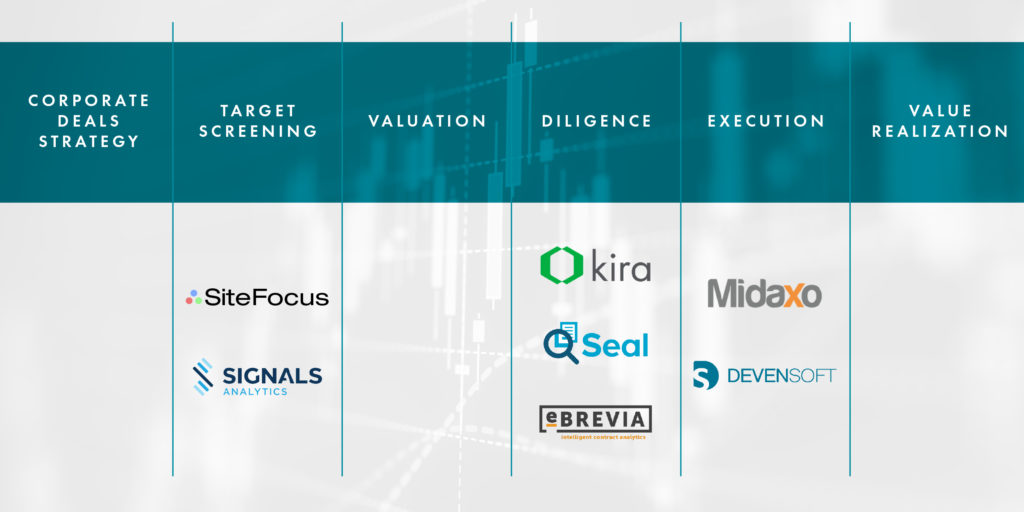Leveraging Analytics and AI in M&A: Tools and Resources
As M&A has become a strategic imperative for most large companies, so has the need to improve efficiency and effectiveness in executing each stage in the process. Considering that in 2018 alone more than $3.35 trillion was exchanged globally in M&A deals, optimizing activities for the best return is critical. Yet, research shows that failure rates for M&A are consistently estimated to be between 70-90% (not meeting the expected return from the acquisition).
From a process perspective, much has remained the same in M&A. Technology has not drastically changed the way that these activities take place to the same extent they have transformed many other facets of business. Traditional practices and time-tested expertise continue to permeate decision making. In the last few years the case for using new technological innovations—particularly in artificial intelligence and analytics—has picked up significant momentum. Technology with relevant applications to M&A is growing increasingly sophisticated, with more use-cases and greater accuracy. These technologies are designed to improve efficiency, speed, and ultimately returns across each stage of the M&A lifecycle (see diagram 1.1).
Diagram 1.1: M&A Lifecycle and Applicable AI/Analytics Technologies
Currently, most technology solutions leveraging AI for M&A are targeted at improving or accelerating due diligence. Tools such as Kira, Seal, and eBrevia specialize in M&A contract analysis to analyze legal documents and highlight areas of concern. Many of these technologies are 150-200x faster than a human and have a 90%+ accuracy rate compared to <85% for lawyers. Given the promise of the technology and the large associated costs, there is clearly opportunity for cost savings and improved ROI.
Given the continuously growing scope and maturity of business analytics, M&A is a natural opportunity area. Some of these include acquisition target identification, pipeline management, and post-merger integration. In target identification, analytics engines such as Signals Analytics can autonomously analyze millions of patent data, press releases, and other pieces of online content to highlight potential target companies for acquisition. Midaxo is a tool that has several solutions for pipeline tracking and integration project management. Leveraging analytics of this nature to organize tasks, highlight issues, and streamline processes, a company undertaking an acquisition has the opportunity to better visualize its pipeline, effectively manage it, and earn a greater return faster.
Barriers to Acceptance of AI in M&A
While technologies are becoming increasingly sophisticated across all of their business applications, there is still mixed interest and hesitancy to apply such tools in M&A. On one hand, analytics is gaining a strong foothold, with around two thirds of executives reporting that they have used analytics tools for M&A purposes. AI, however, has been slower to catch on. Part of the reason may be the greater complexity of the technology, but there are also barriers on an emotional level. M&A has long been a field that highly values deep expertise and personal experience. In most deals, there is a certain element of “gut-feel” which ultimately drives a portion of the decisions made during the process. The more AI that is applied, the more that is removed from the equation, challenging strong cultural norms in the industry.
There is also the barrier to trust that outputs from technology are 100% accurate. It’s an interesting phenomenon: in the previously-cited study of lawyers and AI in M&A due diligence, the humans had an average accuracy rate of 85%. Even the highest-performing lawyers could only achieve an accuracy of 94%. The AI applied to the same data set had an accuracy rate of 94%–meaning that it was just as accurate as the best lawyers. Yet our human biases are often still wary of trusting technology to make decisions that have such a large human impact. Often, teams have no tolerance for inaccuracy from technology, even if the result will still be “better” than that of a human counterpart.
Addressing the Gap in Technologies for M&A Stages
The reality is, there is something about the human element that just cannot be wholly replaced by cold hard data. At least, not yet. That’s why the stages of M&A which by nature are more suited for deep analytical analysis — due diligence, for example—are prime for technology solutions. Even target identification, while slightly more art than science, can increasingly be pared down to a large sets of data points with variable characteristics.
But as M&A gets further down the pipeline, more nuances come into play and pure logic to make decisions just doesn’t suffice. Those last few steps—getting from two or three potential targets down to the one, the valuation, settling the terms of the deal—still involve a mix of strategy, market conditions, executive expertise, and a dash of human emotion. As AI continues to support more and more business applications at higher degrees of achievement, those differentiations will become narrower. And as they do, M&A teams should watch closely to take advantage of the best-fit tools and solutions as they come along.
Explore M&A Consulting and Advisory Services
Subscribe to Clarkston's Insights
Coauthor and contributions by Katerina Baduk and Evan Shirley



